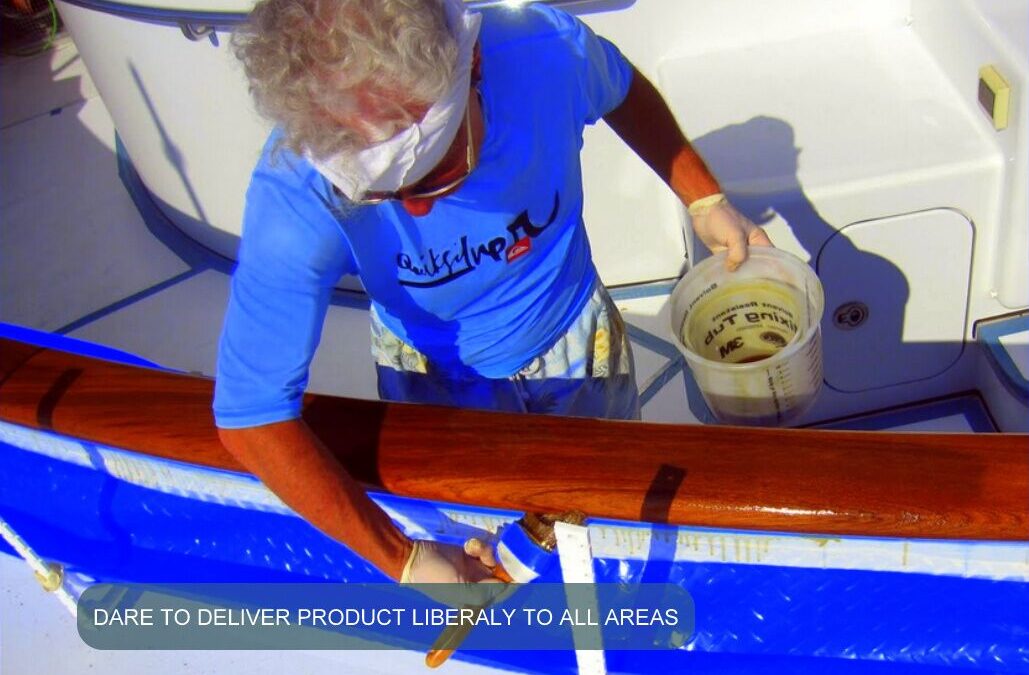By Scott Van Allen, Founder at Railstar Marine and Ecopreneur in Blue Economy
The Railstar source control system was not developed by an intern at one of the large marine conglomerates, nor does it – at first glance – exude high-tech. It was derived over the course of many refits, in an on-going quest for a pragmatic approach to achieving a greater mileage of product delivered via brush to intended yacht structure.
For me, the capping and toe rails on yachts stood out as areas that needed improvement. Whilst I determined that I enjoyed applying clear coat systems onboard yachts, it was also becoming evident that getting a final payment could be difficult when/if there were drips on the customer’s deck, scuppers, rubbing states or on topside paint work. Traditional single stage varnish drips were more easily addressed, however the age of longer-lasting acrylic urethanes was now well upon us by mid 90’s. Not to mention the other new issues to be considered.
- The delivery of material in heat and wind lessened the likelihood of an acceptable and credible (not overly reduced) coating.
- Now the cost of a coat came in at 3 to 4 times greater than previously, as with former trend-tech.
- Respirators, latex gloves, and graduated mixing pots became part of one’s shopping list.
- It could be a worst nightmare if while on your watch a mess was made on client’s paintwork.
Let’s outline a few of the user-friendly and practical implements of the Railstar solution (aside from the obvious eco-implications).
 On one occasion I was delivering a double–stage acrylic urethane mixed with minimum possible reducer. It was a very hot and exceptionally windy day in Florida. I’ve now re-developed my technique to “Dare-to- Deliver” thicker more credible coatings without concern for any run-off material, or brush trails. When delivering, I now get the brush WET and apply with more volume add viscosity than one would normally dare to. This extra volume of product delivered to surface affords more time to brush – maneuver a “hot-mix” into place. However, an applicator can achieve a much more credible result, more millage of material without brush trails as the weight and volume of the product is now self-leveling somewhat. The facility to lay down double plus millage per application enables twice the depth effect, add durability, and longevity.
On one occasion I was delivering a double–stage acrylic urethane mixed with minimum possible reducer. It was a very hot and exceptionally windy day in Florida. I’ve now re-developed my technique to “Dare-to- Deliver” thicker more credible coatings without concern for any run-off material, or brush trails. When delivering, I now get the brush WET and apply with more volume add viscosity than one would normally dare to. This extra volume of product delivered to surface affords more time to brush – maneuver a “hot-mix” into place. However, an applicator can achieve a much more credible result, more millage of material without brush trails as the weight and volume of the product is now self-leveling somewhat. The facility to lay down double plus millage per application enables twice the depth effect, add durability, and longevity.
This also lends efficacy to the delivery with volume of material to the underneath areas of the rail (whereas often receives considerably less.) You’ve most likely never seen an applicator re-dip the brush to apply material to underneath rolled edges of a rail. But using Railstar, the tradesman is able to “babysit” or control upwards of 3 meter sections whilst the material remains still workable. Remember; this example is with a high viscosity hot-mix of acrylic urethane on a hot windy day.
Everyone likes the 3rd eye. This mirror-like material which is known as “Styro-Glass,” is made out of thin plastic with a fine reflective film on one side; is flexible and may be cut into ideal lengths and widths for intended use. Inexpensive and reusable, it can also be used for scrapping and sanding. Our wish is that this 50 cent hack will save you as many “re-do’s” as I can only imagine it has for our team.
Owners, captains and project managers seem to welcome the concept of the varnish crews getting in and out.
You may call it source control or you can call it procedural stewardship. That’s my story, Railstar is my system, and I’m sticking to it.

Want to hear more from Superyacht Technology News? Subscribe to our magazine free!

